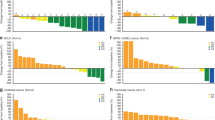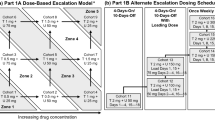Abstract
Purpose: This study addressed theefficacy and toxicity of the novel compoundBryostatin-1 (NSC 339555), a novel agentwith antineoplastic, hematopoietic andimmunomodulatory activity in a variety ofin vitro and in vivo systems.
Patients and methods: This phase IIstudy randomly assignedchemotherapy-naïve patients withuntreated metastatic melanoma andmeasurable disease to two schedules oftreatment: Arm A, 25 μg/m2bryostatin-1 given as a 24 hour continuousinfusion weekly or Arm B,120 μg/m2 bryostatin-1 given as a72 hour continuous infusion every 2 weeks.Although objective response was assessedusing standard NCIC CTG criteria,antitumour activity was assessed using amultivariate endpoint incorporating bothresponse (CR and PR) and early progression(PD at ≤ 8 weeks). Seventeen patientswere randomized to each arm.
Results: Arm A was better tolerated with 86.7% of15 evaluable patients receiving ≥ 90%of planned dose intensity versus 76.5% of17 evaluable patients in Arm B. On Arm B,three patients experienced serious adverseevents and three patients had to be removedfrom protocol therapy due to toxicity. Themost common side effect was myalgia (33%grade 1–2 on Arm A versus 65% on Arm Bwith 5 patients experiencing grade 3 andone patient grade 4). Lethargy was morecommon on Arm A but more severe on Arm B. Other side effects such as nausea, diarrheaand headache were generally mild tomoderate in nature and occurred with asimilar frequency on both arms. Hematologicand biochemical toxicity were minimal. This trial was closed early because theprotocol-stopping rule was met based onlack of required responses and on thenumber of early progressions on both arms.No partial or complete responses were seen;3 patients randomized to Arm A had stabledisease (duration 9–24 weeks) as did 4patients (duration 10–38 weeks) randomizedto Arm B.
Conclusion: Arm A wasbetter tolerated than Arm B. We concludethat bryostatin-1 has little efficacy inthe treatment of metastatic melanoma witheither of the schedules studied.
Similar content being viewed by others
References
Pettit GR, Herald CL, Doubeck DL, Herald DL: Isolation and structure of bryostatin-1. J Am Chem Soc 104:6846–6848, 1982
Hess AD, Silanskis MK, Esa AH, Pettit GR, May WS: Activation of human T lymphocytes by bryostatin-1. J Immunol 141:3263–3269, 1988
Berkow RL, Kraft AS: Bryostatin, a non-phorbol ester macrocyclic lactone, activates intact human polymorphonuclear leukocytes and binds to the phorbol ester receptor. Biochem Biophys Res Commun 131:1109–1116, 1985
May WS, Sharkis SJ, Esa AH, Gebbia V, Kraft AS, Pettit GR, Sensenbrenner LL: Antineoplastic bryostatins are multipotential stimulators of human hematopoietic progenitor cells. Proc Nat Acad Sci USA 84:8483–8487, 1987
Asieud C, Biggs J, Lilly M, Kraft AS: Inhibition of leukemic cell growth by the protein kinase C activator bryostatin-1 correlates with the dephosphorylation of cyclin dependent kinase 2. Cancer Res 55:3716–3720, 1995 (abstr)
Esa AH, Boto WO, Adler WH, May WS, Hess AD: Activation of T-cells by bryostatins: induction of the IL-2 receptor gene transcription and down-modulation of surface receptors. Int J Immunopharmacol 12:481–490, 1990
Lilly M, Vo K, Le T, Takahashi G: Bryostatin-1 acts synergistically with interleukin-1 alpha to induce secretion of g-csf and other cytokines from marrow stromal cells. Exper Hematol 24:621, 1996 (abstr)
Kraft AS, Woodley S, Pettit GR, Gao F, Coll JC, Wagner F: Comparison of the antitumor activity of bryostatins 1, 5, and 8. Cancer Chemother Pharmacol 37:271–278, 1996
Szallasi Z, Du L, Levine R, Lewin NE, Nguyen PN, Williams MD, Pettit GR, Blumberg PM: The bryostatins inhibit growth of B16/F10 melanoma cells in vitro through a protein kinase C-independent mechanism: dissociation of activities using 26-epi-bryostatin-1. Cancer Res 56:2105–2111, 1996
Philip PA, Rea D, Thavasu P, Carmichael J, Stuart NS, Rockett H, Talbot DC, Ganesan T, Pettit GR, Balkwill F, Harris AL: Phase I study of bryostatin-1: assessment of interleukin 6 and tumor necrosis factor alpha induction in vivo. The Cancer Research Campaign Phase I Committee. J Natl Cancer Inst 85:1812–1818, 1993
Zee B, Melnychuk D, Dancey J, Eisenhauer E: Design of phase II clinical trials incorporating response and early progression. Controlled Clin Trials 17(2S):85S, 1996
Dent S, Zee B, Dancey J, Hanauske A, Wanders J, Eisenhauer E: Application of a new multinomial phase II stopping rule using response and early progression. J Clin Oncol 19(3):785–791, 2001
Fleming TR: One sample multiple testing procedure for phase II clinical trials. Biometrics 38:143–151, 1982
Propper DJ, Macaulay V, O'Byrne KJ, Braybrooke JP, Wilner SM, Ganesan TS, Talbot DC, Harris AL: A phase II study of bryostatin-1 in metastatic malignant melanoma. Br J Cancer 78:1337–1341, 1998
Bedikian A, Plager C, Papadopoulos N, Eton O, Ellerhorst J, Smith T: Phase II trial of bryostatin-1 in patients with melanoma. Proc Am Soc Clin Oncology. 18:523a, 1999 (abstr)
Gonzalez R, Ebbinghaus S, Henthorn T, Miller D, Kraft S: Treatment of patients with metastatic melanoma with bryostatin-1 - a phase II study. Melanoma Res 9:599–606, 1999 (abstr)
Schuchter LM, Esa AH, May WS, Laulis MK, Pettit GR, Hess AD: Successful treatment of murine melanoma with bryostatin-1. Cancer Res 51:682–687, 1991
Varterasian ML, Mohammad RM, Shurafa MS, Hulburd K, Pemberton PA, Rodriguez DH, Spadoni V, Eilender DS, Murgo A, Wall N, Dan M, Al-Katib AM: Phase II trial of bryostatin-1 in patients with relapsed low grade non-hodgkins lymphoma and chronic lymphocytic leukemia. Clin Cancer Res 6:825–828, 2000
Kamanda W, Smith M, Mohammad RM, Al K: Quantitative RT-PCR for mdr1 RNA in cell lines and in xenografts after bryostatin-1. Proc Ann Meeting Am Assoc Cancer Res 35:A3248, 1994 (abstr)
Scala S, Dickstein B, Regis J, Szallasi J, Blumberg P, Bates S: Bryostatin-1 affects P-glycoprotein phosphorylation but not function in multidrug-resistant human breast cancer cells. Clin Cancer Res 1:1581–1587, 2000
Author information
Authors and Affiliations
Rights and permissions
About this article
Cite this article
Tozer, R., Burdette-Radoux, S., Berlanger, K. et al. A Randomized Phase II Study of Two Schedules of Bryostatin-1 (NSC339555) in Patients with Advanced Malignant Melanoma – A National Cancer Institute of Canada Clinical Trials Group Study. Invest New Drugs 20, 407–412 (2002). https://doi.org/10.1023/A:1020694425356
Issue Date:
DOI: https://doi.org/10.1023/A:1020694425356




